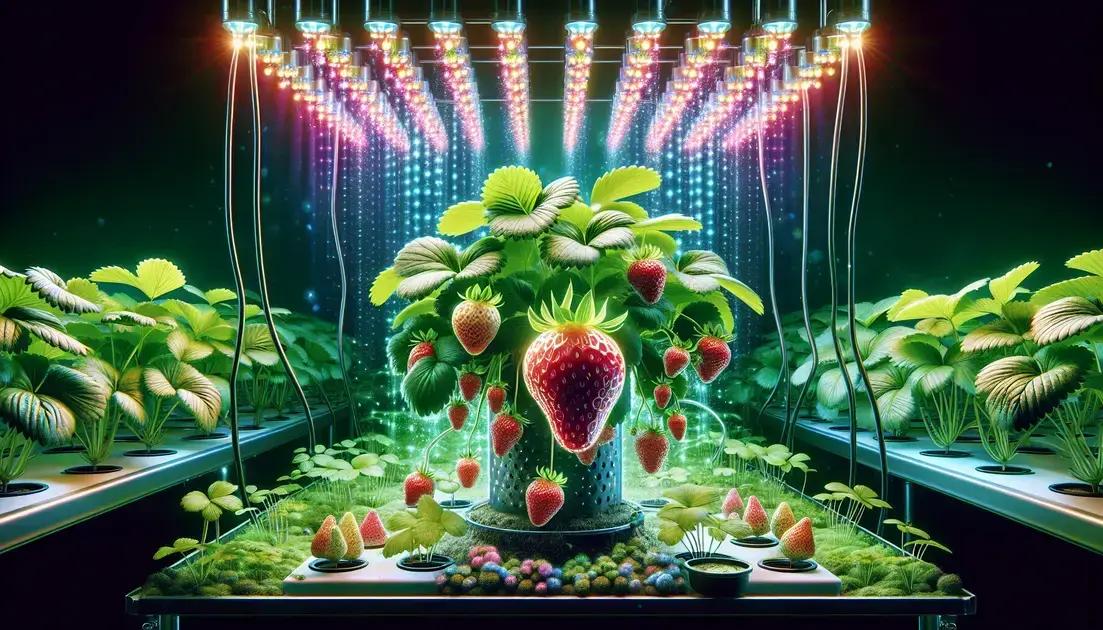Ever imagined growing your own strawberries at home? With **hydroponic systems**, it’s not only feasible but can yield impressive results. The key lies in the nutrient solution used. Let’s delve into how you can make the most of it!
selecting the right hydroponic system for strawberries
Selecting the ideal hydroponic system for growing strawberries at home involves considering factors like the available space, maintenance, and your budget. Several systems work well with strawberries, such as nutrient film technique (NFT), deep water culture (DWC), and ebb and flow.
NFT systems are popular due to their efficiency. They involve a constant flow of nutrient solution over the plant roots, allowing strawberries to receive a steady supply of nutrients and oxygen.
DWC systems are suitable for beginners. In this setup, strawberry roots are suspended in a nutrient-rich water tank, receiving essential nourishment continuously. It is simple to set up and manage.
The ebb and flow system, also known as flood and drain, periodically floods the growing area with nutrient solution and then drains it away. This process mimics natural water cycles, providing oxygen and nutrients to strawberry plants effectively.
When selecting a system, consider the space you have at home, how much time you can dedicate to maintenance, and your level of experience with hydroponics. Proper research and planning can significantly impact your strawberry yield and overall success.
understanding strawberry nutrient needs

Strawberries have specific nutrient needs that are essential for optimal growth in hydroponic systems. Key nutrients include nitrogen, phosphorus, and potassium, often referred to as macronutrients. These elements support leaf development, flowering, and fruit production.
Nitrogen is fundamental for the development of lush green foliage. It plays a critical role in photosynthesis, allowing strawberry plants to convert sunlight into energy.
Phosphorus is vital for the formation of flowers and fruits. It aids in transferring energy and supports the root system, which is crucial for nutrient uptake.
Potassium contributes significantly to fruit quality. It enhances the flavor and sweetness of strawberries and is important for regulating water and nutrient transport within the plant.
In addition to these, micronutrients such as iron, calcium, and magnesium are also necessary. These elements support various physiological functions that keep the plants healthy and productive. Ensuring a balanced nutrient solution can lead to bountiful harvests and delicious strawberries.
preparing the perfect nutrient solution
Creating the perfect nutrient solution for hydroponic strawberries involves precise balance. Begin by selecting a high-quality, hydroponic-specific fertilizer blend. These blends typically contain essential macronutrients like nitrogen, phosphorus, and potassium, and crucial micronutrients such as iron, calcium, and magnesium.
Dissolve the fertilizer in water according to the manufacturer’s guidelines, which ensures the right concentration. Use a pH meter to measure the solution’s acidity. Strawberries thrive in a pH range of 5.5 to 6.5. If adjustments are needed, use pH up or down solutions to stabilize the levels.
Next, check the electrical conductivity (EC) of the solution. This measures the nutrient concentration. For strawberries, maintaining an EC between 1.5 and 2.5 mS/cm is ideal. Use a conductivity meter for this task. Adjust nutrient levels accordingly to match the specific growth stage of the plants.
Consistent monitoring and adjustments of the nutrient solution ensure optimal plant health and yield. Replace the solution regularly to prevent the buildup of salts and imbalances. Success lies in maintaining these conditions throughout the growing cycle.
managing pH and electrical conductivity

Managing the pH and electrical conductivity (EC) in hydroponic systems is vital for the health and productivity of strawberries. These elements influence nutrient availability and uptake by the plants.
A pH meter is essential to monitor acidity levels, as strawberries thrive within a 5.5 to 6.5 pH range. If the pH drifts from this range, nutrient absorption can be hindered. Adjust pH levels using a reliable kit with pH up or pH down solutions to maintain the ideal balance.
The EC meter measures the concentration of nutrients dissolved in the water. Maintaining an EC between 1.5 and 2.5 mS/cm ensures plants receive adequate nutrients. High EC can lead to salt buildup and nutrient burn, whereas low EC might indicate a lack of nutrients.
Regularly check and adjust the pH and EC levels in the nutrient solution. This practice helps in preventing nutrient lockout and ensures robust growth. Keep logs to track any adjustments and environmental changes for better management over time.
troubleshooting common hydroponic issues
Troubleshooting common hydroponic issues can help ensure a healthy strawberry crop. Nutrient deficiencies, often indicated by leaf discoloration, can be resolved by adjusting the nutrient solution. Ensure the correct balance of nitrogen, phosphorus, and potassium.
Algae growth is another issue often caused by light exposure to the nutrient solution. To prevent this, use opaque containers and keep the system covered. Regular cleaning of the system also helps reduce algae and bacteria buildup.
Root rot is identified by brown, mushy roots and is usually due to inadequate oxygenation or waterlogged conditions. Ensure proper aeration by using air stones or pumps and maintain good drainage in the system.
pH imbalances can cause nutrient lockout. Use a pH meter frequently and adjust levels within the ideal range for strawberries, between 5.5 and 6.5. Also, inspect plants regularly for pests like aphids or mites, and treat infestations promptly with organic insecticides to maintain plant health.
alternative methods for enhancing strawberry growth

Exploring alternative methods can significantly enhance strawberry growth in hydroponic systems. One approach is the use of LED grow lights to supplement natural light. These lights provide the specific wavelengths strawberries need for photosynthesis, promoting healthier growth year-round.
Another technique is integrating beneficial microbes into the nutrient solution. These microbes improve nutrient uptake and protect plants from diseases, fostering a robust growth environment.
Implementing vertical growing systems maximizes space, allowing more plants to thrive in limited areas. This method improves air circulation and light exposure, helping the strawberries develop better.
Regularly pruning and training the plants ensures they focus energy on fruit production instead of excessive leaf growth. Removing runners and dead leaves redirects nutrients to the fruits, enhancing their size and sweetness.
Summarizing hydroponic strawberry cultivation
Growing strawberries hydroponically at home offers exciting possibilities for high yields and delicious fruits. By carefully selecting the right systems and understanding the nutrient needs, you can ensure robust plant growth.
Managing pH and electrical conductivity is crucial, as is troubleshooting any challenges that arise. Exploring alternative methods, like using LED lights and vertical setups, also enhances growth.
With these techniques and considerations, even beginners can enjoy the satisfaction of cultivating tasty, home-grown strawberries. Embrace these methods and watch your hydroponic garden flourish.
FAQ – Frequently Asked Questions About Hydroponic Strawberry Cultivation
What is the best hydroponic system for strawberries at home?
Systems like nutrient film technique (NFT) and deep water culture (DWC) are ideal due to their ease of use and efficiency.
How do I prepare the perfect nutrient solution?
Select a quality hydroponic fertilizer, maintain a pH of 5.5-6.5, and ensure an electrical conductivity (EC) of 1.5-2.5 mS/cm.
Why is pH management crucial in hydroponics?
Maintaining the correct pH ensures optimal nutrient absorption, preventing deficiencies and promoting healthy growth.
What common issues might I face in hydroponics?
Issues include nutrient imbalances, algae growth, root rot, and pests. Regular monitoring and maintenance can prevent these issues.
Can alternative methods improve strawberry yield?
Yes, methods like using LED grow lights, beneficial microbes, and vertical growing systems can significantly enhance plant health and yield.
How often should I monitor my hydroponic system?
Regularly check the pH, EC, and overall plant health. Weekly inspections can help catch and address issues early.



